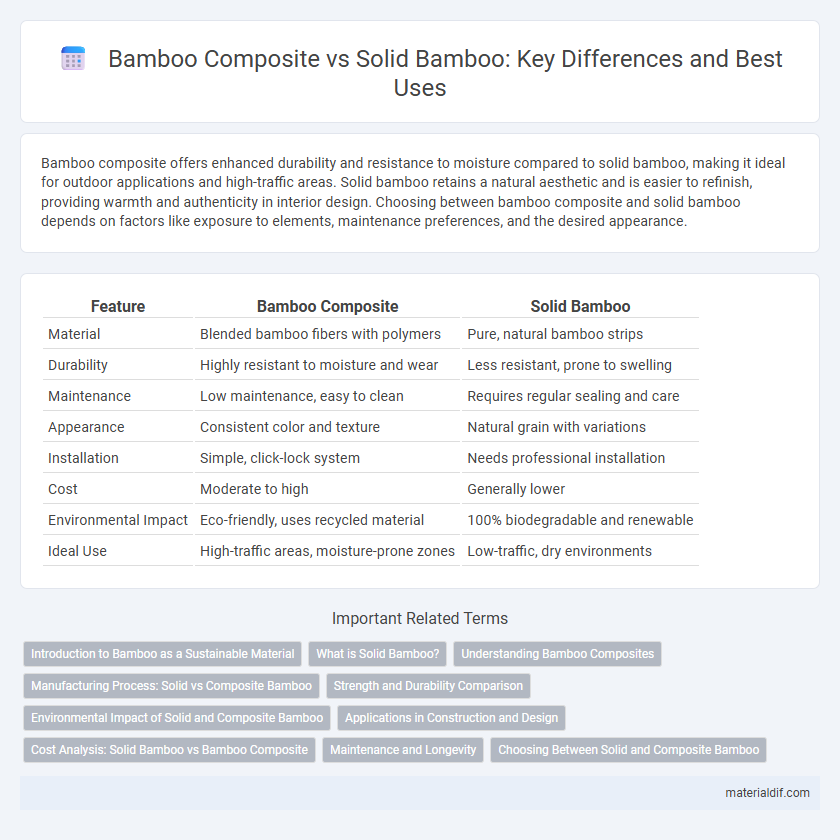Bamboo composite offers enhanced durability and resistance to moisture compared to solid bamboo, making it ideal for outdoor applications and high-traffic areas. Solid bamboo retains a natural aesthetic and is easier to refinish, providing warmth and authenticity in interior design. Choosing between bamboo composite and solid bamboo depends on factors like exposure to elements, maintenance preferences, and the desired appearance.
Table of Comparison
| Feature | Bamboo Composite | Solid Bamboo |
|---|---|---|
| Material | Blended bamboo fibers with polymers | Pure, natural bamboo strips |
| Durability | Highly resistant to moisture and wear | Less resistant, prone to swelling |
| Maintenance | Low maintenance, easy to clean | Requires regular sealing and care |
| Appearance | Consistent color and texture | Natural grain with variations |
| Installation | Simple, click-lock system | Needs professional installation |
| Cost | Moderate to high | Generally lower |
| Environmental Impact | Eco-friendly, uses recycled material | 100% biodegradable and renewable |
| Ideal Use | High-traffic areas, moisture-prone zones | Low-traffic, dry environments |
Introduction to Bamboo as a Sustainable Material
Bamboo composite combines bamboo fibers with adhesives, enhancing durability and resistance to moisture compared to solid bamboo, which consists of natural bamboo strips or boards. Both forms offer exceptional sustainability due to bamboo's rapid growth rate, carbon sequestration capabilities, and minimal environmental impact during harvesting. Bamboo composites provide improved performance for construction and design applications, while solid bamboo maintains its natural aesthetic and structural integrity.
What is Solid Bamboo?
Solid bamboo is made from whole bamboo stalks compressed and bonded together to create durable, dense planks ideal for flooring and furniture. Unlike bamboo composite, which combines bamboo fibers with adhesives and resins for enhanced stability, solid bamboo retains the natural grain and strength of the bamboo culm without additional fillers. This makes solid bamboo highly resistant to wear, eco-friendly, and suitable for applications requiring robust, natural materials.
Understanding Bamboo Composites
Bamboo composites combine natural bamboo fibers with resins or adhesives to enhance strength, durability, and resistance to moisture compared to solid bamboo. This engineered material offers superior dimensional stability and uniformity, making it ideal for flooring, furniture, and structural applications where solid bamboo may warp or crack. Understanding the manufacturing process of bamboo composites highlights benefits like improved hardness and eco-friendliness due to efficient use of bamboo resources and recyclability.
Manufacturing Process: Solid vs Composite Bamboo
Solid bamboo is crafted from single bamboo stalks that are cut, dried, and treated to retain natural strength and durability, while composite bamboo is produced by shredding bamboo fibers and bonding them with adhesives under heat and pressure to form engineered boards. The manufacturing process of composite bamboo allows for enhanced uniformity, increased dimensional stability, and resistance to warping compared to solid bamboo. This engineered approach also facilitates customization in size and thickness, making composite bamboo ideal for diverse construction and furniture applications.
Strength and Durability Comparison
Bamboo composite exhibits higher strength and superior durability compared to solid bamboo due to its engineered structure, which integrates bamboo fibers with resin binders, enhancing resistance to warping, cracking, and moisture damage. Solid bamboo, while naturally strong and flexible, is more susceptible to environmental stressors and insect attacks, reducing its long-term performance in outdoor or high-moisture applications. The composite's uniform density and improved mechanical properties make it ideal for flooring, furniture, and structural uses where longevity and robustness are critical.
Environmental Impact of Solid and Composite Bamboo
Solid bamboo is highly sustainable due to its natural growth process, rapid renewability, and minimal processing, resulting in a low carbon footprint and biodegradability. Bamboo composite, made by binding bamboo fibers with adhesives, involves higher energy consumption and use of synthetic resins, which can release volatile organic compounds (VOCs) and impede biodegradability. Choosing solid bamboo significantly reduces environmental impact through lower emissions and easier recycling compared to composite alternatives.
Applications in Construction and Design
Bamboo composite offers enhanced durability and resistance to moisture and pests, making it ideal for exterior applications such as decking, cladding, and outdoor furniture in construction and design. Solid bamboo provides natural aesthetics and strength suitable for interior flooring, wall panels, and furniture, benefiting from its renewable and lightweight properties. Both materials contribute to sustainable building practices, but bamboo composites deliver superior performance in environments exposed to weathering and heavy use.
Cost Analysis: Solid Bamboo vs Bamboo Composite
Solid bamboo generally offers a lower upfront cost compared to bamboo composite due to simpler manufacturing processes and reduced material treatment requirements. Bamboo composite, while more expensive initially, provides enhanced durability, resistance to moisture, and reduced maintenance expenses over time. Evaluating long-term value reveals that bamboo composite can yield cost savings through its extended lifespan despite the higher initial investment.
Maintenance and Longevity
Bamboo composite requires less maintenance compared to solid bamboo due to its enhanced resistance to moisture, insects, and UV damage, resulting in longer-lasting performance. Solid bamboo, while natural and eco-friendly, often needs regular sealing and protection to prevent warping and decay. Properly maintained bamboo composite decking can extend its lifespan up to 25 years, whereas solid bamboo typically lasts around 10-15 years under similar conditions.
Choosing Between Solid and Composite Bamboo
Choosing between solid bamboo and bamboo composite depends on durability and application needs. Solid bamboo offers natural strength and aesthetic appeal, ideal for flooring and furniture that require a traditional, organic look. Bamboo composites, engineered from bamboo fibers combined with resins, provide enhanced resistance to moisture and wear, making them suitable for outdoor projects and high-traffic areas.
Bamboo composite vs solid bamboo Infographic

 materialdif.com
materialdif.com